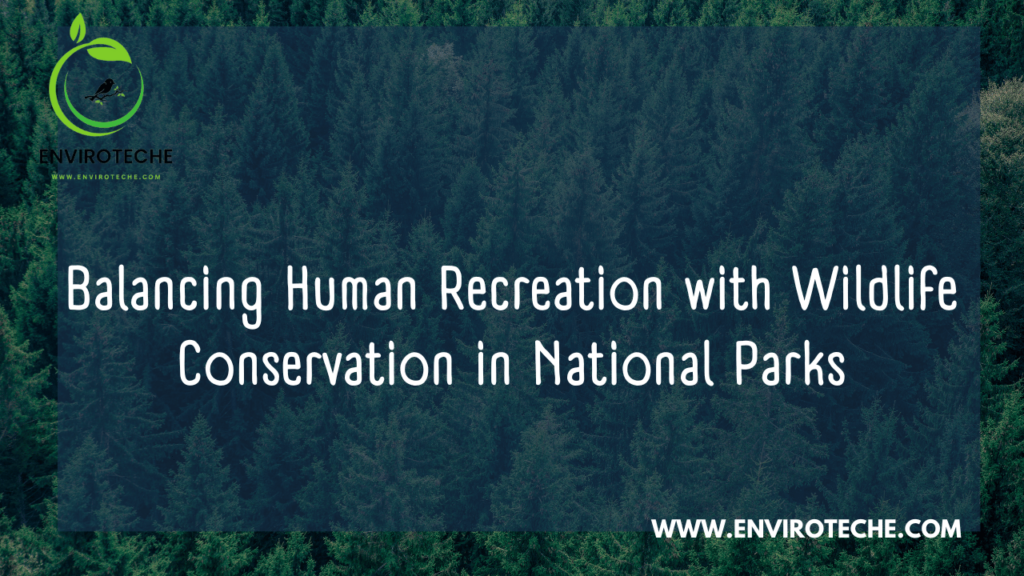Authors:

Qudrat Ullah1, Muhammad Qasim1
1Department of Environmental Science, Government college university Faisalabad
Wildlife Conservation are often home to a diverse diversity of flora and animals, including endangered species, and have significant cultural and historical significance. National parks are critical for preserving biodiversity, minimizing the effects of climate change, and facilitating scientific study. They also provide a wide range of recreational opportunities, such as hiking and camping, as well as wildlife viewing and photography, all of which improve physical and mental well-being and build a greater respect for the natural world. In a nutshell, National Parks are critical to the preservation of our planet’s natural history and a valuable resource for present and future generations.
Human Recreation in National Parks:
Visitors can engage in a variety of leisure activities in national parks, such as hiking, camping, fishing, boating, wildlife viewing, and more. These activities enhance physical exercise, lower stress levels, and improve mental health, among other benefits to human wellness. Recreational activities in national parks can also increase local economies by attracting tourists and creating jobs. However, these actions may also harm wildlife, disrupting breeding and nesting grounds, destroying habitats, and escalating conflicts between people and animals. In order to ensure that future generations can continue to enjoy these protected areas while also protecting the natural habitats and biodiversity within them, it is crucial to strike a balance between human leisure and wildlife conservation activities in National Parks.
Wildlife Conservation in National Parks:
A wide variety of wildlife can be found in national parks, from giant predators like grizzly bears and wolves to tiny creatures like birds and rodents. These parks are essential for the preservation of wildlife populations because they conserve habitat and enable species to flourish free from the effects of human development.
However, a number of challenges, such as habitat loss and fragmentation, climate change, invasive species, and poaching, affect wildlife in national parks. A range of tactics are used in national park conservation initiatives, including habitat restoration, the reintroduction of endangered species, and public outreach and education to encourage safe behaviour around animals. Despite these initiatives, the protection of wildlife in national parks continues to be a problem that need for constant attention and assistance from park administrators, governmental organisations, and the general people.
Balancing Human Recreation with Wildlife Conservation:
For national parks all across the world, striking a balance between wildlife conservation and human pleasure is essential. Effective management techniques are needed to control the growing number of park visitors while simultaneously preserving the parks’ fragile ecosystems and fauna. Setting restrictions on the number of visitors and the permitted activities is one method of controlling human recreation. Other methods include offering tourists educational and interpretive programmes and putting trail and facility maintenance programmes into place.
Restoring habitat, creating monitoring and research programmes, and taking steps to lessen human-animal conflicts are all strategies for safeguarding wildlife. In parks like Banff National Park in Canada, where wildlife crossings have been built to reduce wildlife fatalities on roads, and Kruger National Park in South Africa, where community-based conservation programmes have been implemented to engage local communities in protecting wildlife, successful examples of balancing human recreation with wildlife conservation can be seen. The survival and viability of National Parks depend on striking a balance between human leisure and wildlife conservation.
Conclusion:
In conclusion, it is critical for the long-term viability of these natural assets to strike a balance between human leisure and wildlife conservation in National Parks. While National Parks provide a variety of leisure activities that can benefit people in many ways, including by encouraging physical activity, improving mental health, and promoting education and awareness of the natural world, they also act as vital habitats for many wildlife species that are crucial to the health of our ecosystems.
We must priorities the preservation of species and their habitats while also employing prudent management techniques to reduce the detrimental effects of human recreation if we are to maintain the ecological integrity of these sites. This entails lowering visitor numbers, upholding rules, and encouraging sensible visitor conduct. It is our duty to utilise our national parks wisely and sustainably so that future generations can continue to appreciate these natural treasures for many years to come. We all have a part to play in maintaining our national parks.
Check Other Schlorships:


Great job.